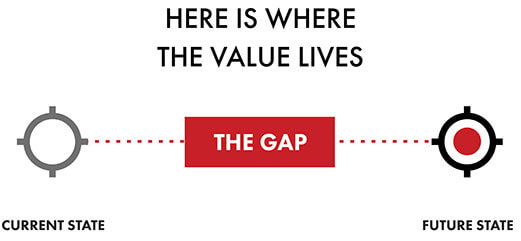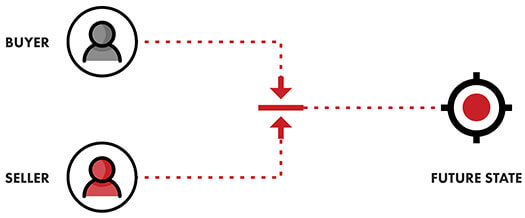GAP SELLING: PROBLEM CENTRIC™
SALES TRAINING
A Proven 21st Century Sales Training Method
Are your…
- Win rates too low?
- Sales cycles too long?
- Average deal sizes shrinking?
You’re not alone. We get it, and we get how to fix it.
These problems often happen because sales reps struggle with discovery and bore buyers with canned demos.
Then, reps push monthly discounts to buy now, when they can’t even articulate why they should buy, and why they should buy now…
This all leads to skyhigh CAC, reduced profitability, inaccurate forecasting, losing to the status quo and more…
Sound familiar?
Diagnose the root cause & learn how to solve these problems with a Gap Selling expert today ->
I Need Sales Training!
FAQ
How is GAP Selling training different?
The right sales methodology is not enough. For sales training to be effective it must be delivered in a way that maximizes retention, initiates behavioral change and translates to the sellers buyer environment. GAP Selling Sales Training is built on a foundation of adult learning principles and change management with a strong focus on live practice and consistent coaching. Each training is tailored to your unique buyer environment through exercises that ensure focus is on execution, not sales theory. For this reason, it is not uncommon for students to apply the learning to current opportunities and see wins before they even complete the session. Put simply, GAP Selling Sales Training is different because it is built to drive results.
How does the Gap Selling Methodology specifically improve win rates in the areas of overcoming status quo and competition?
Central to this methodology is the understanding that sales revolve around change, which is only considered when a problem exists. Gap Selling employs the PIC (Problem Identification Chart) to help sellers craft a compelling business case for change, focusing on the problems in the buyer's environment, their impacts, and the technical root causes. The first critical decision in the buyer's journey, “Should I change at all?”, is where most sales are traditionally lost, often to the status quo. Traditional sales methods leap directly to convincing buyers to choose their solution, neglecting the vital step of justifying the need for change itself. Gap Selling addresses this by clearly defining and assessing the buyer's problems and their impacts, thus ensuring that the proposed change is justified. This approach not only prevents the loss of potential deals but also aids in identifying unviable deals early, thereby saving time and improving forecast accuracy.
After establishing the necessity of change (the first decision), the Gap Selling methodology shifts to the second decision: “Should I change with you?”. This stage is crucial for differentiating from the competition. Traditional sales strategies often rely on discussing general product features, which can leave buyers overwhelmed and uncertain. In contrast, Gap Sellers focus on a clear diagnostic and alignment of the Problem-Product connection, providing the buyer with a clear understanding of how their offering specifically addresses the root causes of the buyer's issues. This clarity builds buyer confidence, sets correct expectations, and lays the groundwork for successful implementation. Moreover, this approach allows sellers to effectively counter any objections, even when competing products have additional features, by demonstrating how their solutions are more closely aligned with solving the buyer's problems. Such a focused approach significantly enhances the seller's ability to outperform the competition.
How do you develop a unique Point of View (POV) to earn the right to discovery?
A Sales Growth Company does not subscribe to a telling philosophy. We highly caution against a sales organization trying to gain credibility by telling a buyer a story or POV. This often has the opposite effect. Particularly if the POV misses the mark.
Imagine you are at your first visit with a doctor. Would you find it unsettling and/or frustrating if a doctor started the first visit by sharing a POV from another patient, medical journal, or diagnosis, before asking you questions or diagnosing you personally?
It’s for this reason, Gap Selling leverages the PIC to teach sellers how to ask world class diagnostic questions of the buyer. Gap Sellers are coached how to learn and understand their customer’s point of view first. Only then is a POV shared.
The development of the Co-Authored Problem Identification Chart will become the foundation of a problem-centric point of view. When a salesperson has an intimate understanding of the problems, impacts, and root causes their buyers may be experiencing, each relevant question increases the buyers’ confidence that perhaps the the salesperson can help them.
What Is The Gap Selling Methodology
The Gap Selling Methodology is a sales technique that shifts the focus of the sale from your product to the buyer’s problem. In old-school selling methodologies, focusing on the features and benefits of your product meant the buyer had all the power when it came to understanding the prospect’s true needs. With Gap Selling, we teach you how to find the gap– the space between the buyer’s current and future states– and utilize that information to sell to the real problem the buyer is experiencing.


HOW IS IT DIFFERENT
FROM OTHER METHODOLOGIES?
Gap Selling teaches you how to be Problem-Centric™. We don’t pitch about our product or service, and we don’t try to find the customer’s “pain point” to manipulate a sale. Gap Selling is a collaborative effort with the buyer to identify the true source of the problem, evaluate the cost of that problem, and work together to find a solution to fill the gap.



